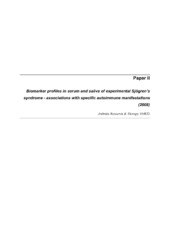The autonomy of different aspects of Sjögren´s syndrome and their treatment in an experimental model: the use of comprehensive biomarker analyses to characterize the disease and the effect of heat-shock proteins in treatment intervention
Doctoral thesis
Permanent lenke
https://hdl.handle.net/1956/3823Utgivelsesdato
2008-06-20Metadata
Vis full innførselSamlinger
Sammendrag
Sjögren’s syndrome (SS) is a systemic rheumatic disease, in which the salivary and lacrimal glands are the principal targets of a pathological autoimmune reaction. Clinically, SS is manifested by keratoconjunctivitis sicca (dry eyes) and xerostomia (dry mouth). Histopathologically, the disease is characterized by persistent focal mononuclear cell infiltration in the salivary glands. Traditionally, loss of secretory capacity, degree of lymphoid infiltration and production of specific autoantibodies were anticipated to correlate with each other and indicate disease state and disease severity. The correctness of this assumption was, however, difficult to prove. The aim of the first study was to clarify the chronology of the SS disease course and to describe possible interrelationships between sialoadenitis and hyposalivation. We could confirm that the SS in non-obese diabetic (NOD) mice is characterized by at least two distinct phases. In our study, inflammation of the salivary glands preceded the onset of hyposalivation with a considerable amount of time. Interestingly, the onset of hyposalivation was not associated with a significantly higher degree of inflammation. Significant alterations in cytokines in serum and saliva paralleled the transition from the pre-clinical to the overt disease state. The purpose of the second study was to acquire knowledge on 87 immunologically relevant proteins measured in serum and 75 proteins analyzed in saliva. Thirty-eight biomarkers analyzed in serum and 34 proteins in saliva from NOD mice were significantly altered when compared to Balb/c mice. Eighteen biomarkers in serum and 3 chemokines in saliva had the potential to predict individual strain-membership with 80-100% accuracy. Computation of a correlation network led to the conclusion that processes related to the adaptive immune system promote SS with a strong implication of T-helper (TH)2 related proteins in hyposalivation. In addition, the SS-related disease manifestations appeared to be associated with different immunological processes and did not correlate with each other. Cluster of differentiation (CD)40, CD40L, interleukin-18, granulocyte chemotactic protein-2 (GCP-2) and anti-muscarinic M3 receptor immunoglobulin G3, may, however, interrelate the different aspects of SS. The study further established saliva as an attractive biofluid for biomarker discovery in SS and provides a basis for the comparison and selection of potential drug targets and diagnostic markers. The third study was conducted to investigate a potential immunomodulatory effect of heatshock protein 60kDa (Hsp60) and Hsp60-derived peptide aa437-460 (aa437-460) immunization on spontaneous experimental SS. Administration of Hsp60 and aa437-460 significantly reduced SS-related histopathology compared to the untreated NOD controls. In addition, 50% of Hsp60 and 33% of aa437-460 injected mice retained normal exocrine function. Both treatments induced similar changes in the biomarker profiles, which indicated decreased inflammatory chemotaxis and strengthened anti-inflammatory regulatory pathways. Successful prevention of hyposalivation was accompanied by quantitative alterations in 36 biomarkers, of which 19 inflammatory mediators declined to levels comparable to the measurements obtained in Balb/c mice. Molecules involved in inflammatory chemotaxis, neovascularization and regulatory pathways coined the differences displayed by the biomarker profiles. In addition, specific biomarker signatures had the capability to accurately predict the received treatment, treatment efficacy and impaired exocrine function. Common to all three studies were the appearing independence of the different aspects of SS and the valuable information we could extract from biomarker analyses especially in saliva.
Består av
Paper I: Arthritis & Rheumatism 54(7), Jonsson, M. V.; Delaleu, N.; Brokstad, K. A.; Berggreen, E.; Skarstein, K., Impaired salivary gland function in NOD mice: association with changes in cytokine profile but not with histopathologic changes in the salivary gland, pp. 2300-2305. Copyright 2006 American College of Rheumatology. Published by John Wiley & Sons. Full text not available in BORA due to publisher restrictions. The published version is available at: http://dx.doi.org/10.1002/art.21945Paper II: Arthritis Research & Therapy 10(R22), Delaleu, N.; Immervoll, H.; Cornelius, J.; Jonsson, R., Biomarker profiles in serum and saliva of experimental Sjögren’s syndrome: associations with specific autoimmune manifestations. Copyright 2008 Delaleu et al.; licensee BioMed Central Ltd. Reproduced with permission. Published version. The published version is also available at: http://dx.doi.org/10.1186/ar2375
Paper III: Arthritis & Rheumatism 58(8), Delaleu, N.; Madureira, A. C.; Immervoll, H.; Jonsson, R., Inhibition of experimental Sjögren’s syndrome through immunization with heatshock protein 60kDa and its peptide aa437-460. Published as: Inhibition of experimental Sjögren's syndrome through immunization with HSP60 and its peptide amino acids 437-460, pp. 2318 – 2328. Copyright 2008 American College of Rheumatology. Published by John Wiley & Sons. Full text not available in BORA due to publisher restrictions. The published version is available at: http://dx.doi.org/10.1002/art.23656
